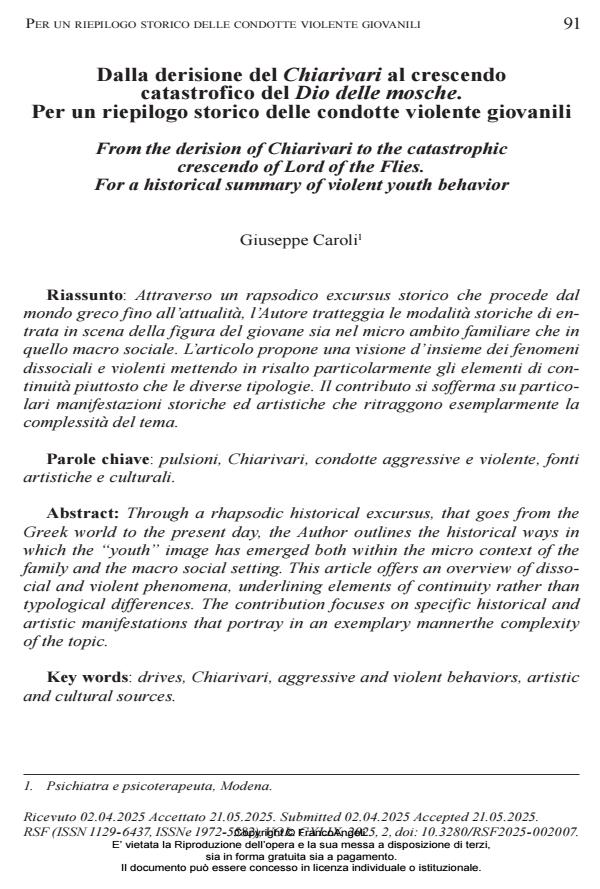From the derision of Chiarivari to the catastrophic crescendo of Lord of the Flies. For a historical summary of violent youth behavior
Journal title RIVISTA SPERIMENTALE DI FRENIATRIA
Author/s Giuseppe Caroli
Publishing Year 2025 Issue 2025/2
Language Italian Pages 11 P. 91-101 File size 194 KB
DOI 10.3280/RSF2025-002007
DOI is like a bar code for intellectual property: to have more infomation
click here
Below, you can see the article first page
If you want to buy this article in PDF format, you can do it, following the instructions to buy download credits

FrancoAngeli is member of Publishers International Linking Association, Inc (PILA), a not-for-profit association which run the CrossRef service enabling links to and from online scholarly content.
Through a rhapsodic historical excursus, that goes from the Greek world to the present day, the Author outlines the historical ways in which the “youth” image has emerged both within the micro context of the family and the macro social setting. This article offers an overview of dissocial and violent phenomena, underlining elements of continuity rather than typological differences. The contribution focuses on specific historical and artistic manifestations that portray in an exemplary mannerthe complexity of the topic.
Keywords: drives, Chiarivari, aggressive and violent behaviors, artistic and cultural sources.
- [1.] Freud S. Saggi sulla teoria sessuale. In: Opera Omnia. Torino: Bollati Boringhieri; 1980.
- [2.] Schindler N. Tutori del disordine. In: Levi G, Schmitt JC(eds). Storia dei giovani, vol.1: Dall’antichità all’Età moderna. Bari: Laterza; 1994.
- [3.] Mitterauer M. I giovani in Europa dal Medio Evo ad oggi. Bari: Laterza; 1991.
- [4.] Cardini F. Alle radici della cavalleria medievale. Bologna: Il Mulino; 2014.
- [5.] Martines L. Savonarola. Moralità e politica a Firenze del ‘400. Milano: Mondadori; 2008.
- [6.] Minois G. Storia del riso e della derisione. Bari: Dedalo; 2004. [7.] Dickens C. Le avventure di Oliver Twist. Milano: BUR; 1953.
- [8.] Goethe JW. I dolori del giovane Werther. Milano: Bompiani; 1987. [9.] Foscolo U. Ultime lettere di Jacopo Ortis. Milano: Bompiani; 1988.
- [10.] Caroli G. La creazione dell’adolescenza. Cinema e psiche vol.2. Messina: Kimerik; 2023.
- [11.] Shakespeare W. Romeo e Giulietta. Firenze: Sansoni; 1970. [12.] Simenon G. Gli sconosciuti in casa. Milano: Mondadori; 1961. [13.] Burgess A. Arancia meccanica. Torino: Einaudi; 2022.
- [14.] Ministero dell’interno, Report criminalità minorile 2010-2022, 2023. [15.] Lancini M. Essere adolescenti nell’epoca del sovranismo psichico. Sestante 2019; 4, 7: 3-7.
- [16.] Lancini M. L’adolescente. Milano: Raffaello Cortina, Milano; 2020. [17.] Marcelli D, Braconnier A. Psicopatologia dell’adolescente. Milano: Masson; 1983
- [18.] De Martino E. La fine del mondo. Contributo all’analisi delle apocalissi culturali. Torino: Einaudi; 1988.
- [19.] Haid J., La generazione ansiosa. Milano: Rizzoli; 2024. [20.] Laing R. L’io diviso. Torino: Eimaudi; 1959.
- [21.] Golding W. Il signore delle mosche. Milano: Mondadori; 2017.
- [22.] Fruggeri L. Dal costruttivismo al costruttivismo sociale: implicazioni tecniche e terapeutiche. Psicobbiettivo 1988; 18, 1: 37-48.
Giuseppe Caroli, Dalla derisione del Chiarivari al crescendo catastrofico del Dio delle mosche. Per un riepilogo storico delle condotte violente giovanili in "RIVISTA SPERIMENTALE DI FRENIATRIA" 2/2025, pp 91-101, DOI: 10.3280/RSF2025-002007